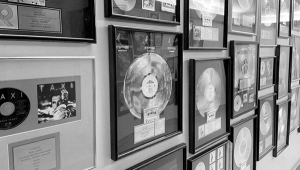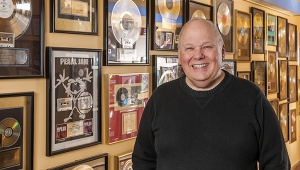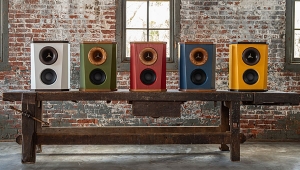| Columns Retired Columns & Blogs |
Richard Vandersteen: Keep on Truckin'
Richard Vandersteen doesn't look like a typical loudspeaker designer. True, he wears glasses, but his presence suggests a longshoreman or somebody who'd be played by Gene Hackman. And sure enough, he tells you in a quasi-Dukes of Hazzard drawl that he's been a construction worker, plumber, truckdriver, and electrician. Electronics had always been a hobby, but Vandersteen formalized his understanding by working in electronics during his stint in the Air Force. Back in civilian life, Vandersteen entered into speaker manufacture, producing the "baffleless" range, at least regarding the midrange driver and tweeter, which bears his name. The speakers, particualrly the Model 2 and its variants, have become, in a decade, one of America's most respected brands, despite RV's low-profile marketing techniques. I met with Richard at the Las Vegas CES in January and asked him what had got him started in loudspeaker design.
Richard Vandersteen: I came up with this idea for a speaker without a baffle in 1972, and started building them for people in our local area. A high-end store opened up nearby in Visalia, California, and they said "Let's take these things to Chicago." It was 1977. I said "Where?" because I didn't know of the Consumer Electronics Show. I took vacation time from my job, met something like 30 dealers and got 200 orders for about 250 pairs. I went back, told the boss I gotta quit, gotta find a building, because we were doing it in the garage and it was too small for that. That's how it started.
Ken Kessler: What inspired you to throw away the baffle for the mid and treble drive-units?
Vandersteen: In some of the experiments in the early designs, we were flush-mounting drivers, and I was sealing them in with silicone. My wife has a favorite record which has a saxophone on it—it was stolen, I don't remember what it was—but it was one of her favorite records and I used it a lot for testing. I'd blown a midrange and had no more new drivers, so to make sure it was still working without all of the problem of removing the silicone, which was very difficult to get out, I just laid the midrange up on top. My wife was around the corner in the kitchen; she said, "Richard, what did you do to the stereo? It sounds so much more real." I said, "Actually, it's not right." So I took the other midrange out and laid it up on top, and then went into the garage and got a stick and laid the tweeter on it, and that's where we came up with a tube. The problem was this thing was real ugly; she said, "There's no way you're going to leave those in the living room."
About three weeks later, as I was hanging up my jacket, I said, "closet pole." Then my wife sewed up some double-knit fabric which was in at that time—it's not any more—and made a sock to go around the loudspeaker because, she said, "you could never sell them that way."
Of course, three, four, five years later out comes the KEF 105 and the B&W 801 and they did very well with that modular affair. But that was the beginning of the Vandersteen range. It's the same design today; I just keep refining it with better drivers. The company finally got large enough that we could get custom drivers made, and that helped a lot. We wind our own capacitors, and on and on.
Kessler: The striking thing is, of course, the lack of a baffle. But that flies in the face of tradition. As everyone knows, the baffle isn't just there as something to hold the driver. The baffle affects dispersion, it reinforces the sound. How do you account for something that went completely against traditional lore for box-type loudspeakers?
Vandersteen: Partly by experiments. If you take a perfect tweeter and mount it in a baffle, of course you can put it in the baffle asymmetrically, round the corners and minimize the effect of the baffle, but the baffle is still there. However, you do have a problem when you have no baffles in that there is no averaging; with a baffle, when you strike your first boundary at a quarter-wavelength, you get a 3dB increase. And this is nice; by positioning the drivers you can be quite a bit cruder on the crossover and still get flat power response. So we did have to get involved in extensive use of compensating networks and phase networks and so forth to make the drivers work without the assistance of a baffle, without any averaging going on, to make the speaker flat.
The crossover technology was the most difficult part of the design. Exactly as you said, you don't have this averaging effect that comes from the baffle. In hindsight, this is why the smaller speakers that were and still are popular in England always seem to be more natural when you have them out in the room: they in themselves have a lot of their frequencies unbaffled and . . .
Kessler: . . . behave like point sources?
Vandersteen: Yeah, exactly. The closer you can space that driver group, the better, the more realistic the speaker will sound in a room. And that's for two reasons: If you have a large source, even if it works as a true piston—let's assume 6' tall and 1' wide—you can, by designing it properly, make the sound hit the ear of the listener perfectly in phase. But you'd have a problem. The way the ear/brain works, as long as it has clues as to its environment, it's very good at separating your living room from the Steinway in that room. It should do the same with hi-fi. If your source is too large, you can design that source, with dynamic drivers or planar drivers or whatever, to hit the listener properly, but what gets all balled up are the phase differences and the time delay in all the room reflections. Even if you damp the room, no material is 100% effective in damping, and no material I've found is totally linear in its absorption characteristics. You end up with false clues.
For instance, if you put a squarewave into a Quad '63 (which behaves in a manner akin to a point source), you can get somewhat of a squarewave out of that speaker at the listening position. You could turn the microphone to the rear wall, side walls, up to the ceiling, anywhere, and all of the reflections within that room will be pretty close in shape to the original pulse that came directly from the speaker. You cannot do that with a multi-unit dynamic loudspeaker. You may have the individual drivers focused with delay and everything precisely on the listener so that you can make the squarewave hit the listener, but when you start looking at the reflections in the room, it's hopelessly messed up. There will be no recognition of the original pulse at all.
So I looked at perfecting that idea too, making sure that group was close, and that it loaded the room in a realistic way, so that all of that reflective energy would come to the listener in phase, or in sync.
Kessler: But you mentioned earlier that the biggest problem with baffleless driver mounting was compensating for phase and so on via the crossover. In taking care of the benefits of having a baffle which you sacrifice by not having a baffle, didn't you just trade one set of problems for another? In other words, you sacrificed a mechanical cure and replaced it with an electronic cure. Aren't they equally complex, equally flawed?
Vandersteen: They are equally complex, but the electrical cure is much easier to control. You aren't really trading one problem for another because when you get that first near-field reflection, the ear/brain combination has a very difficult time separating the source from the garbage. It's such a small period of time, and the ear is not so much an amplitude device as it is a time device. I think this goes back to prehistoric times, when you had to know where the bear was coming from. For instance, if you phoned me from England, I would recognize you, even though the telephone is a horrendous amplitude device. The ear uses time signatures and phase and so on; that's how we recognize what's realistic and what isn't.
Of course, we haven't accomplished perfection. Eliminating the baffle eliminates all of these earlier errors, because sound radiates from a transducer like ripples from a pebble dropped in a pond. When those rings first strike the baffle board, even if the board is padded with something or the corners are rounded (that helps minimize the problems of the baffle because it splays and averages the diffraction and keeps it from focusing on the listener), it is still a problem because there is a lot of time distortion in that diffraction. I have test equipment that can measure that very easily. You put in a source, hit it again with the same source, then vector the two together to get the difference of what came from the drivers and what came from the baffle. What comes from the baffle is not linear at all. It's a mess.
Kessler: Yes, but you do compensate for that. You know what its characteristics are when you design a speaker with a baffle.
Vandersteen: You can accomplish flat amplitude response; it's easy to do that. But you can never correct for a time distortion.
Kessler: But there are other time distortions created by not having the rigidity of a tweeter and a midrange driver mounted on a baffle, which has to be greater than free-standing supports.
Vandersteen: We have a free-standing support, obviously, which is actually a small box. It doesn't matter, it could be a column, but the boxes are small enough, in order to make them very strong. Because of their columnar effect, you don't have to worry about the resonances in these materials because all these parts are different sizes. I use different thicknesses of wood, different damping material on the inside, so that if you assume everything has a problem, at least they never add on top of another. It's kind of like the random theory. But as long as those structures are less than a quarter-wavelength of the driver frequencies, you can say it's baffleless even though theoretically there's a very small box there. The old LS3/5A, for example, with the exception of frequencies over 5k and the sharp edges around there, was basically a baffleless speaker in my opinion. So is any other mini-monitor, at whatever frequency of which the dimension of the baffle is less than a quarter wavelength. Which goes quite high up in the midrange on a mini-speaker. And that, I think, is why, even though they have a lot of other problems—a small speaker's distortion is very high—they're still pleasant from a musical standpoint because they have minimized the time distortions created by baffle reflections.
Kessler: What are the aspects of a baffleless design that prevent it from attaining the levels of openness and absolute transparency of, say, a dipole, or a panel-type loudspeaker?
Vandersteen: That's a very good question. Panel speakers have a high end that is exaggerated in a way that's kind of opposite to a lot of recordings, but in the midrange—this is just my opinion—in the midrange, they have a genuine realness. Every one of them. Even the bad designs have a genuine something about them that just sounds so damn real. This has puzzled me for 17 years, but I think I've discovered what it is—they have no diffraction problems behind them until they hit the rear wall. So you don't get those minor time distortions you get from a baffle, when its energy is reflected and delayed and sent back to the listener no longer in phase or correct in amplitude, because you have to have a problem in the driver offset by a problem in the crossover and/or the baffle. You get too many wrongs trying to make a right, and I basically don't believe in that.
- Log in or register to post comments




































